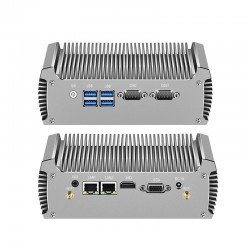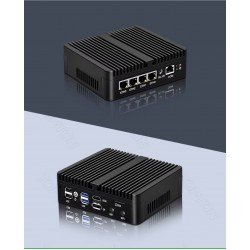
Performance, Security and Savings for Enterprises and Providers
In the increasingly connected and distributed world of modern IT, network solutions must be flexible, scalable and secure. In this context, software like OpenWRT represents a game changer for enterprises, public entities and service providers. But what makes OpenWRT such an advantageous choice? In this article, we will explore in depth all the concrete benefits resulting from the adoption of this platform.
1. Advanced and Customizable Connectivity
OpenWRT offers advanced network management thanks to a modular and software-defined approach. Its main capabilities include:
Professional routing and switching: support for dynamic (BGP, OSPF, RIP), static and policy-based protocols.
VLAN, VPN and complex bridge support: perfect for hybrid or multi-tenant environments.
Failover and load balancing: guarantees reliability and continuity of services even in the event of a line interruption.
Broad hardware compatibility: can be installed on generic hardware, embedded routers, rack servers, VMs or containers, offering maximum flexibility.
With OpenWRT, the network infrastructure becomes programmable, easily integrated with orchestration tools (such as Ansible or NetBox) and adaptable to specific business needs.
2. Enterprise-class security
In an era where cybersecurity is a top priority, OpenWRT excels with a set of integrated protection features:
Stateful and application-level firewalls (with iptables/nftables support).
Integrable IDS/IPS (Snort, Suricata) for proactive threat detection.
Centralized VPN management (IPsec, WireGuard, OpenVPN): secure encrypted connections between offices, branches and remote devices.
Access control, QoS and 802.1x authentication: for secure and segmented enterprise networks.
Unlike many commercial solutions, OpenWRT allows complete and transparent control of security policies, without having to submit to “black-box” logics.
3. High Performance even on Modest Hardware
One of the most appreciated surprises by those who adopt OpenWRT is the efficiency with which the system manages resources:
Low-level optimizations for high performance even on low-power ARM or x86 CPUs.
Optional hardware acceleration for VPN or NAT encryption (where supported).
Multi-gigabit routing on low-cost devices thanks to lean kernels and network stacks.
This also allows small and medium-sized businesses to obtain performance comparable to high-end solutions, without expensive investments in branded equipment.
4. Drastic Cost Reduction
5. Scalability and Automation for the Future
Thanks to its modular architecture and full compatibility with the Linux world, OpenWRT is extremely scalable and ready for modern environments:
Container and virtualization support for cloud and on-premise environments.
Integration with CI/CD and DevOps systems for network automation.
REST API, CLI and SNMP support for monitoring and automation.
Active community, constant updates and extensive documentation.
Whether it is SD-WAN, edge computing or smart buildings, OpenWRT can be the heart of a connected, secure and flexible infrastructure.
6. Real Use Cases of OpenWRT
The effectiveness of OpenWRT is not just theoretical: there are numerous companies that use it daily to manage complex, secure and cost-effective networks. Here are some representative use cases:
???? SMB: VPN and Security Without Recurring Costs
Scenario: A company with three branch offices and some employees working from home needed to connect the offices securely, without paying expensive subscriptions to commercial firewalls.
OpenWRT solution:
Implementation of WireGuard tunnels between the offices for encrypted and stable traffic.
Use of integrated firewall and NAT for perimeter protection.
Possibility of secure remote access for staff, via OpenVPN.
Result: 90% savings compared to commercial UTM solutions; simplified IT management and total control over network policies.
???? Local ISP or Wireless Community Network (WISP)
Scenario: A local provider operating in rural areas with limited budgets needed to implement a network with:
Dynamic routing between antennas and radio towers.
QoS for residential and business traffic.
Site-to-site VPN for remote tower management.
OpenWRT Solution:
Use of BGP and OSPF for intelligent and redundant routing.
Bandwidth limits and shaping configured for different customers.
RADIUS server for PPPoE user authentication management.
Result: stable and highly configurable system, with virtually no cost for licenses. OpenWRT has enabled rapid and sustainable expansion of the network.
???? Industry 4.0 and OT (Operational Technology) Environments
Scenario: a manufacturing plant wanted to segment the network between IT and OT, separate networks for machinery, IoT sensors, video surveillance, and provide remote access to maintenance personnel.
OpenWRT Solution:
Creation of isolated VLANs for each device category.
Configuration of granular firewall rules to protect PLCs and SCADA from unwanted traffic.
IPsec VPN for remote access of external technicians.
Result: Compliance with security regulations (IEC 62443), centralized management, increased system uptime, and hardware and software costs under control.
???? Educational Networks and IT Training
Scenario: A technical institute wanted to provide students with real networking and security labs, without investing in Cisco or Fortinet devices.
OpenWRT Solution:
Virtualized labs with OpenWRT on VirtualBox/Proxmox.
Students configured firewalls, NAT, VLAN, DNS, DHCP, VPN, and IDS systems.
Result: High-level hands-on training, at no cost. The software was also adopted by the school administration to connect the branches and control students' internet access.
???? Retail and Franchising: Unified Connectivity between Points of Sale
Scenario: A chain of stores wanted to centralize access to POS, cash registers, and video surveillance systems among over 50 points of sale.
OpenWRT Solution:
Installation of routers with OpenWRT in each point of sale.
Centralized VPN with secure access to management servers.
Centralized monitoring via SNMP and API scripts.
Result: increased security, reduced intervention times and license costs close to zero. Management is completely automated via scripts.
???? Edge Networking and Smart Building
Scenario: in a smart building project with hundreds of IoT sensors, the network infrastructure had to be reliable, segmented and easily monitored.
OpenWRT Solution:
Use of software-defined switches on industrial mini-PCs.
Segmentation of the network into VLANs for HVAC devices, alarms, video surveillance and automation.
VPN for mobile access by technicians.
Result: secure, scalable and fully monitorable environment. Possibility of remote updating of devices without interruptions.
These real-world cases demonstrate how OpenWRT is more than just a software router: it is a strategic tool that can address extremely diverse needs — with the same platform, the same code, and zero licensing costs. From providers, enterprises, schools, or industries, OpenWRT enables a new way of designing networks: intelligent, sustainable, and open.
7. Support and Strong Community
OpenWRT benefits from an active global community, which produces:
In-depth technical documentation
Forums, Telegram/Reddit groups and guides
Collaboration with similar projects (OpenWRT, pfSense, VyOS)
This translates into an accessible learning curve, even for beginners, and a very wide availability of “ready to use” solutions.
???? Technical Details
1. OpenWRT Internal Architecture
Linux-based (Debian or Alpine as a typical base).
Customized kernel with patches to improve network performance (e.g. fq_codel, cake, offloading).
Management via:
Web interface (e.g. modified LuCI or custom dashboard)
Full CLI via SSH
REST API for remote management
2. Common Software Modules
Software Features Used
Firewall iptables, nftables
VPN WireGuard, IPsec, OpenVPN
IDS/IPS Suricata, Snort
Dynamic routing FRR (Free Range Routing)
Load balancing mwan3, custom scripts
Netdata monitoring, Zabbix agent, collectd
Conclusion: Why OpenWRT is the Strategic Choice
Adopting OpenWRT is not just a matter of cost reduction, but a real strategic choice to obtain:
High and stable performance
Integrated and advanced security
Extreme adaptability
Vendor independence
Economic sustainability
In a world where IT needs change rapidly, relying on an open, modular and professional system like OpenWRT allows you to build a solid, secure and future-ready network.







Leave a Comment